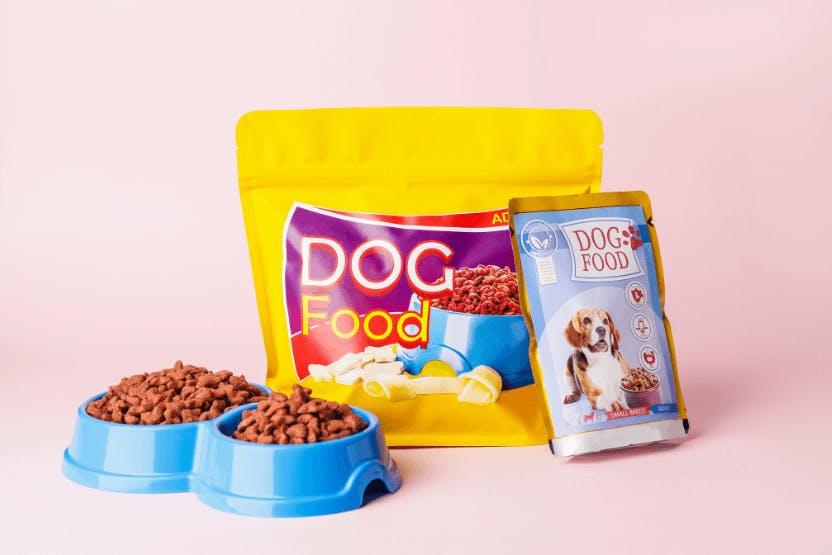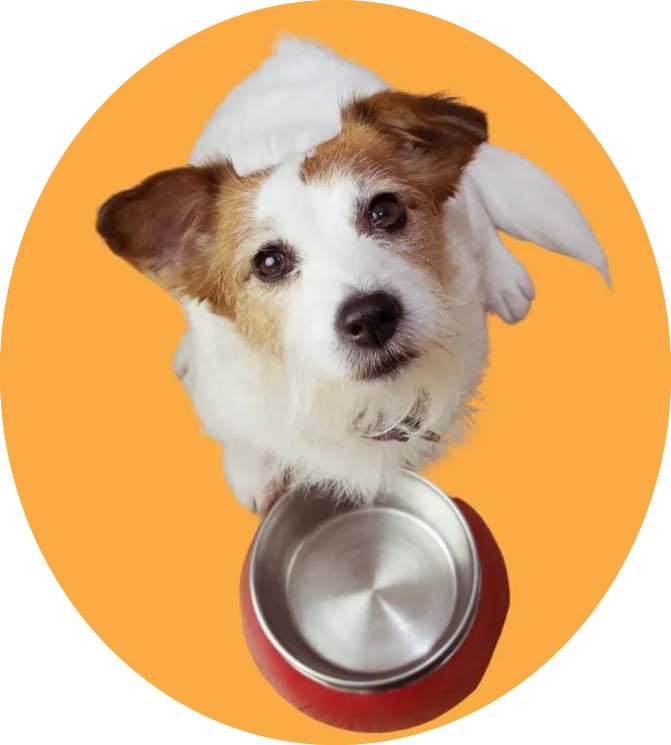- Home
- Dog Wellness
- Ingredient Splitting and Other Tricky Tactics Dog Food Companies Don’t Want You to Know
6 min read
Ingredient Splitting and Other Tricky Tactics Dog Food Companies Don’t Want You to Know

By Emily Bayne
Published: 12/22/2023, edited: 06/14/2024
Save on pet insurance for your pet
You don't have to choose between your pet and your wallet when it comes to expensive vet visits. Prepare ahead of time for unexpected vet bills by finding the pawfect pet insurance.
Overview
Let's face it: the pet food industry doesn't have the best track record for transparency, and sneaky marketing tactics make picking quality pet food easier said than done.
Ingredient splitting, selective wording, and marketing ploys are just a few ways that food companies use to make some lower-quality foods look more nutritious than they are. We'll help you learn to read between the lines on the pet food aisle to ensure you make the most informed decisions paws-sible for your pet's nutrition.
Read on to learn how to spot ingredient splitting and other deceptive ploys when shopping for pet recipes.
What is ingredient splitting?
Ingredient splitting is turning one ingredient into several different products and then listing them independently on the ingredients list. Some say this is a tricky tactic dog food manufacturers use to alter the order of the ingredients list and make foods appear of higher quality than they are.
This practice happens a lot with corn since it's so cheap and versatile, so let's use that as an example.
Pet food manufacturers may take corn, throw a portion of that in, and list it as whole grain corn, take the moisture out of another portion of the corn to make corn syrup, then they might grind down what's left to make corn gluten meal, etc. Before splitting the ingredients, corn would likely be the main ingredient, but since 1 product was split into 3 different ingredients, all the corn products appear further down the ingredients list. This makes it appear that there is less corn than meat sources when, in reality, corn is the primary ingredient.
Why does ingredient splitting happen?
The FDA requires human and pet food companies to include an ingredient list on the nutrition label. This list must be in descending order of how much of each ingredient is added, as determined by the pre-cooked weight of each ingredient.
So, for instance, if a food contains 40 lbs of corn, 30 lbs of meat by-products, and 35 lbs of chicken, the ingredients list would look like this:
- Corn, chicken, and meat-by products. (An actual ingredients list would have many more ingredients)
Ingredient splitting happens when, instead of listing a lower-quality ingredient as one ingredient, manufacturers split the ingredient into several different products and list these products all throughout the recipe when if they had been listed as the original ingredient, it would have to be listed as higher on the list.
So, if we were to split the same corn in the above ingredients into its different parts or products, such as 20 lbs whole grain corn, 15 lbs corn gluten meal, 5lbs of corn syrup, 30 lbs of meat by-products, and 35 lbs of chicken, the ingredients list would instead look like this:
- Chicken, meat by-products, whole grain corn, corn gluten meal, and corn syrup.
Pet food companies claim splitting ingredients in recipes isn't to purposely mislead consumers but that the manufacturers are simply following labeling regulations for their products.
However, some experts argue that this practice is very intentional and makes it look like there is less of a low-quality filler than there really is. Furthermore, they argue that corn, peas, soy, and wheat are the top picks for ingredient splitting because they are versatile, inexpensive, and reduce costs.
How to spot ingredient splitting
So, how do you spot ingredient splitting? The first step is to check the ingredients list for multiple variations of the same ingredient; remember, these ingredients will typically be spaced out throughout the list.
Ingredient splitting will look something like this:
- Chicken, Whole Grain Wheat, Chicken Byproduct Meal (Source Of Glucosamine & Chondroitin Sulfate), Wheat Gluten Meal, Animal Fat (Source Of Omega 6 Fatty Acids [Preserved With Bha/Citric Acid]), Wheat Flour, Meat And Bone Meal, Soybean Meal, Ground Whole Grain Wheat, Natural Flavor, Brewers Rice, Salt, Calcium Carbonate, Monocalcium Phosphate, Potassium Chloride, Choline Chloride, Dried Peas, Dl-Methionine, Vitamine E Supplement, Zinc Sulfate, L-Tryptophan, Yellow 5, Yellow 6, Dried Carrots, Blue 2, Niacin [Vitamin B3], Red 40, Calcium Pantothenate [Source Of Vitamin B5], Copper Sulfate, Sodium Selenite, Potassium Iodide, Vitamin A Supplement, Riboflavin Supplement [Vitamin B2], Vitamin B12 Supplement, Thiamine Mononitrate [Vitamin B1], Vitamin D3 Supplement, Pyridoxine Hydrochloride [Vitamin B6], Folic Acid.
Ingredient splitting can also look like this:
- "Chicken, whole wheat, corn, potatoes, peas, meat byproducts…"
Here, we see multiple different low-quality fillers strung together in succession. This is indicative of ingredient splitting because instead of using one filler (like corn), which would end up comprising the majority of the recipe, they use a moderate amount of several fillers (corn, wheat, peas, potatoes) to make it appear that there's more meat and less filler than there actually is.
Some common examples of ingredients pet food companies like to use for splitting include:
- Corn: Whole grain corn, corn meal, corn gluten meal, corn syrup
- Peas: Peas, pea fiber, pea flour, pea protein
- Wheat: Whole wheat, wheat flour, wheat gluten meal
- Rice: White rice, brown rice, rice flour
- Soy: soy protein isolate, soy flour, soy meal, soybean oil.
These are top choices for ingredient splitting because they are versatile and, most importantly, cheap!
Other tricky tactics some pet food companies employ
Plant protein swap
Some low-quality -pet food manufacturers will use the chemical names of plant proteins to alter the guaranteed analysis and make it look like there is more animal protein than there actually is (the nutrition label doesn't have to specify the amount of animal protein—just the total protein value! You can usually spot this by looking for long chemical-sounding words starting with L and ending in "-ine," like L-lysine, DL-methionine, L-cystine, L-tyrosine, and L-carnitine.
While these amino acids are vital for optimal health and should be included in pet diets, you should also be aware that these can be misleading if animal products aren’t the primary source of protein in a meat-based recipe.
While these amino acids are vital for optimal health and should be included in pet diets, you should also be aware that these can be misleading if animal products aren’t the primary source of protein in a meat-based recipe.
Label phrasing
Beef entree dog food might sound appealing, but be wary of these statements if you see them on a pet food bag. Words like "entree" and "platter" indicate less than optimal nutritional content. You see, labeling regulations are stringent and require careful wording based on the ingredients list. Recipes that say, "meat entree" or "meat platter" can have as little as 10% of that named meat. That percentage drops to 3% for foods labeled "with meat" and less than 3% for those labeled "meat flavor."
Buzzwords
Organic, grain-free, and all-natural foods are all the rage right now. And while these foods can be a great addition to pet diets, there are some things to watch out for when you see these marketing buzzwords on your pet's food label.
Many foods that claim to be organic aren't 100% organic. Like the phrasing of ingredient names we mentioned above, it all boils down to wording. Pet foods claiming to have "organic ingredients" can have up to 30% non-organic ingredients, and those labeled "organic" can contain up to 5% non-organic ingredients. Only foods labeled "USDA organic" or "100% organic" are truly organic and will have a green USDA seal on them.
Likewise, grain-free recipes are soaring in popularity right now due to the rise in information on grain allergies. But grain-free diets aren't always better, especially low-quality ones. Lower-quality grain-free recipes often contain large amounts of legumes, specifically peas, and have been linked to an acquired heart disease called dilated cardiomyopathy.
Looking for grain-free foods for your dog? Here are some of our favorite high-quality grain-free recipes!
How to avoid getting tricked by a nutrition label
Familiarizing yourself with the signs of ingredient splitting and other tricky pet food tactics can help you pick better-quality foods for your pets. Here are some tips to help you avoid getting tricked by a nutrition label:
- Look for ingredients that start with an L and end in "ine" (like L-lysine, DL-methionine, L-cystine, L-tyrosine, and L-carnitine). These words mean that the food has added plant proteins and can indicate that the protein is primarily from plants rather than quality meat sources.
- Don't fall for the first ingredient trickery, either - ingredient splitting can make it look like a named meat source is the main ingredient, but if the ingredients hadn't been split, a low-quality filler would be at the top of the list.
- Look for variations of the same ingredient and multiple fillers toward the top of the list (soy, corn, wheat, peas, etc.)
- Check for the USDA seal if you want to go the organic route (and don't put too much weight on organic claims without the seal)
- Pay attention to the phrasing on the label - meat "entree", meat "flavor", "with meat", meat "platter" etc., can indicate less than optimal protein content.
- Read the ingredients carefully (and pay special attention to the first few!)
- When in doubt, avoid fillers altogether (especially corn, soy, peas, wheat, and rice)
- Ask your vet or a canine nutritionist for their recommendations — they can help you find a quality recipe for your pooch!
Recap
- Ingredient splitting is taking one product into parts and listing these products as separate ingredients.
- Corn, wheat, soy, and peas are the top choices for ingredient splitting because of their versatility and affordability.
- Some pet food companies claim they're just following labeling laws, but the fact stands that if they went by the ingredient name and weight before processing it into different products, the ingredient list would look much different.
- Pay special attention to label phrasing and the ingredients list. Ingredients that begin with an L and end in "ine" (like L-lysine) can be indicators of low-quality recipes in meat-based recipes. If you see those ingredients listed in the guaranteed analysis, it's worth a glance over the ingredients list for other signs that it may be a tricky tactic.
- You should also be wary of pet food with the words "entree," "platter," or "flavor" in the name since these are signs that the recipe has very little meat.
Knowing how much to feed your dog is as important as what you feed them. Check out Dog Food Advisor's Pet Food Calculator for the recommended serving size for your baby!
You may also like
